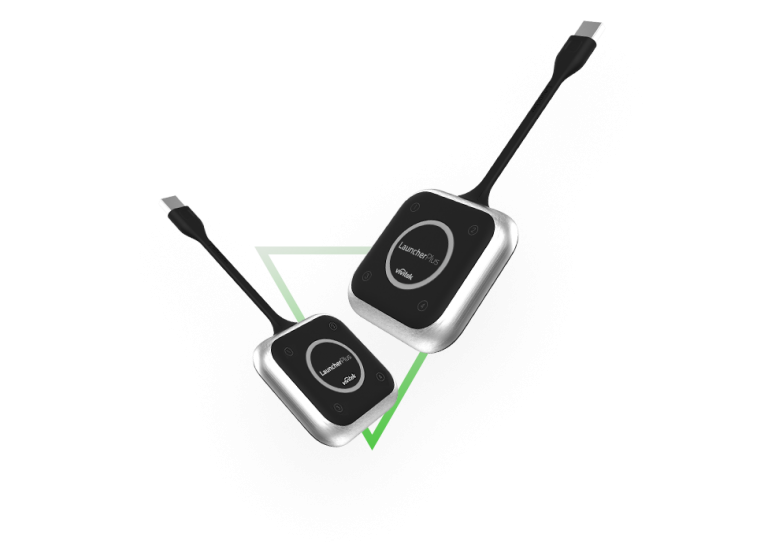
Boards of directors and executive committees have changed significantly in recent years, influenced by the renewal of membership and a new governance culture. Boardrooms and management rooms must therefore naturally accompany this evolution.
In this article, discover four basic trends in these decision-making spaces.
1# Organising the debate
Gone are the days when board members listened quietly to the chairman without asking questions or making remarks.
The boardroom must allow all participants to speak quickly and intuitively, because one thing has not changed in these places of power: the decision-makers have no time to lose!
As far as video is concerned, all the solutions that require network or machine configuration are out; tools that connect directly to the participants’ machines and allow content to be broadcast at the touch of a button are in:

It should not be forgotten in passing that the population concerned by the boardrooms is a heavy user of ultrabooks which have limited connectivity, sometimes reduced to a simple USB port.
The content will be displayed on a large screen visible to all, or even better, on screens placed in front of each participant: visual comfort is of course optimal when everyone is close to the screen; just imagine a financial discussion based on an Excel spreadsheet, etc.
The combination of the two solutions (large central screen + proximity screens) is interesting for juxtaposing two contents: comparison, agenda and working document, resolution before/after modifications, confrontation of solutions, etc. The uses are of course very numerous.
On the audio side, everyone should have a microphone with a tight, deep cardioid for clarity in large meeting rooms. A device to reduce ambient noise is also necessary for the same reason. The microphone will be accompanied by a loudspeaker which significantly increases the listening quality and reduces noise fatigue.
2# Bringing together even the absent
It is pushing an open door to point out that more than ever decision-makers are geographically dispersed. Finding a date when everyone can be physically present significantly slows down the pace of decision-making. A modern boardroom and executive boardroom must therefore necessarily allow for connection with remote participants, as the latter naturally become part of the conversation.
An audio-video conferencing system will therefore be part of the room’s equipment, provided that it is ultra simple to use: a single button to call (like the telephone); likewise a single button to share content from or to the room.
This remote connection must also be able to be made in complete confidentiality, without the risk of hacking.
Legally, it is now accepted that distant board members can vote on most resolutions, except for the most critical ones: election/revocation of the chairman, etc.
3# Speed up decision making
A board of directors is first and foremost there to decide. The boardroom should therefore facilitate these decisions. In addition to the tools described in the first two paragraphs, there are three other features that can speed up the decision-making process:
- Electronic voting. This system is usually combined with the audio-conference tool.
- Automatic broadcasting of the minutes and/or debates
- If several languages coexist within the council, simultaneous translation allows everyone to express themselves using all the subtleties of their native language.
4# Promoting well-being and conviviality
This is also a basic trend in management boards: well-being and conviviality have replaced the austerity of the last century.
In addition, these are meetings that tend to last for a long time because – if everyone is on hand – the chairperson will logically try to cover as many topics as possible during the meeting.
These various elements lead to serious consideration being given to the ergonomics of boardrooms and executive rooms.
Let’s start with the furniture. Seats can be statutory to reflect the importance of the venue, but they should be equipped with a self-weighting tilting mechanism (no time to train board members in the intricacies of the settings under the seat). The boardroom table should be adapted to the number of participants and the shape of the room, but above all it should allow everyone to see themselves and the main screen without contorting.
The lighting should be controllable to allow adaptation to different uses: projection of content, signing of documents, etc. For the latter, a minimum of 200 lux is required on the boardroom table.
The technology -connectics, peripherals and cables- will be discreet and will only be revealed when necessary. The wireless terminals in the room will be generously sized so that every member of the council has comfortable network/internet access.
Finally, we are beginning to see in the boardrooms convivial corners – sofas, armchairs, coffee tables – which juxtapose the boardroom table.
In conclusion, boardrooms have technologies, furnishings and layouts that must be integrated together for immediate efficiency and comfort for all.
Motilde, thanks to its double competence of fitter and will know how to accompany you in the development of your boardroom. Do not hesitate to contact us for a personalized study 😉
Passionate about crafting workspaces that ignite collaboration, innovation, and productivity?
Download our free Ebook :








